Abstract
Turkey erythrocyte membranes were solubilized in the mild detergent octylpenta(oxyethylene) [CH3(CH2)7-(OCH2CH2)5OH], which possesses a high critical micelle concentration (approximately equal to 6 mM) and forms small, dynamic micelles. Both the native enzyme Ns(GDP) X C and the p[NH]ppG-preactivated species N's X p[NH]ppG X C' were found to possess the same molecular mass of 215,000 +/- 17,000 daltons. Both enzyme species migrate as a tight complex between Ns and C on both gel permeation columns and on DEAE-Sephacel columns in detergent. The two functional units, Ns and C, remain associated even in dilute detergent solutions and throughout a 300- to 400-fold purification in octylpoly(oxyethylene). These results strongly support the view that Ns and C do not come apart during the process of enzyme activation by the beta-adrenergic receptor. Furthermore, these results strongly support our previous assertion that the beta-adrenergic receptor activation of adenylate cyclase is by a simple "collision coupling" between the receptor and NsC. These results are not compatible with shuttle mechanisms that postulate that Ns physically migrates from the receptor R to the catalytic unit C and back during the activation cycle, as suggested by Citri and Schramm [Citri, Y. & Schramm, M. (1980) Nature (London) 287, 297-300] and by De Lean et al. [De Lean, A., Stadel, J. M. & Lefkowitz, R. J. (1980) J. Biol. Chem. 255, 5108-5117].
Full text
PDF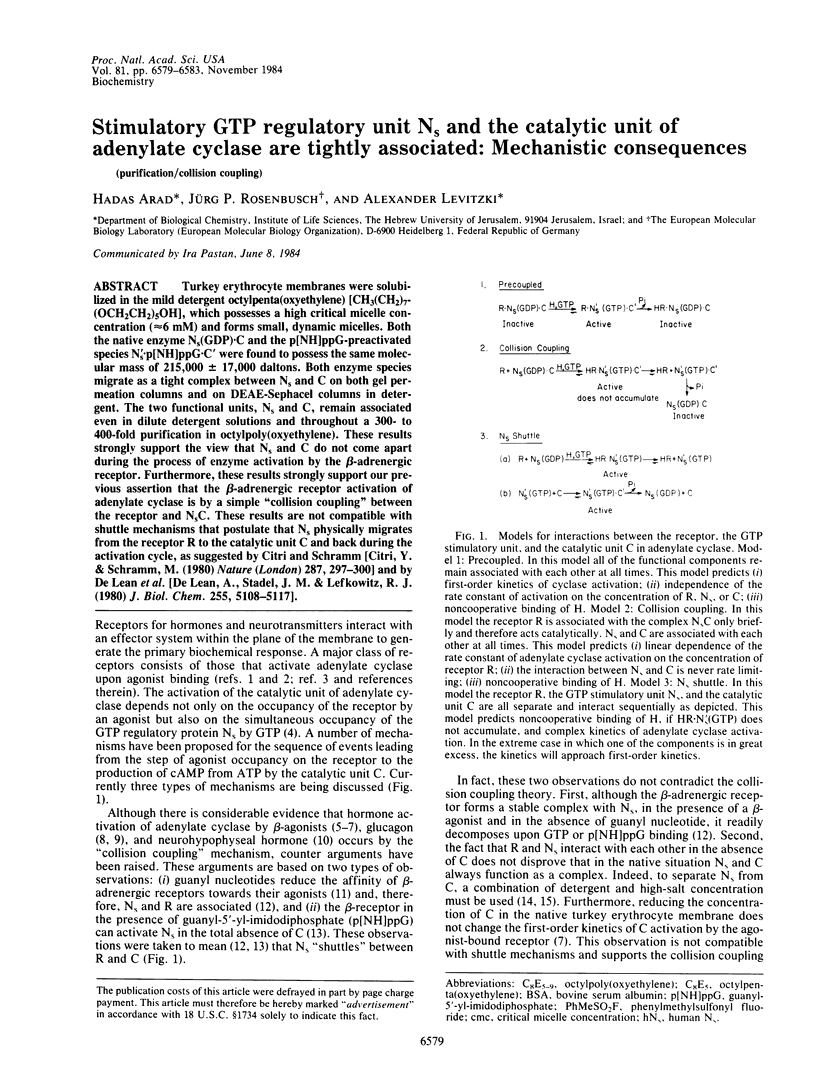
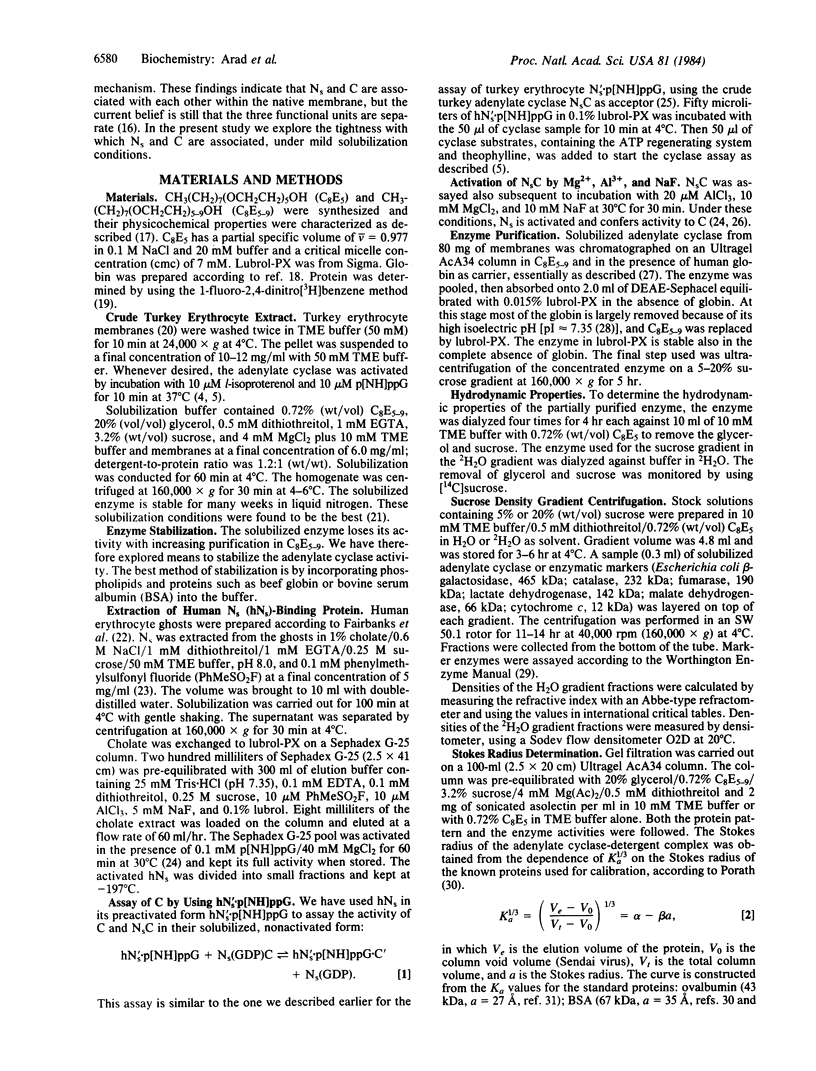
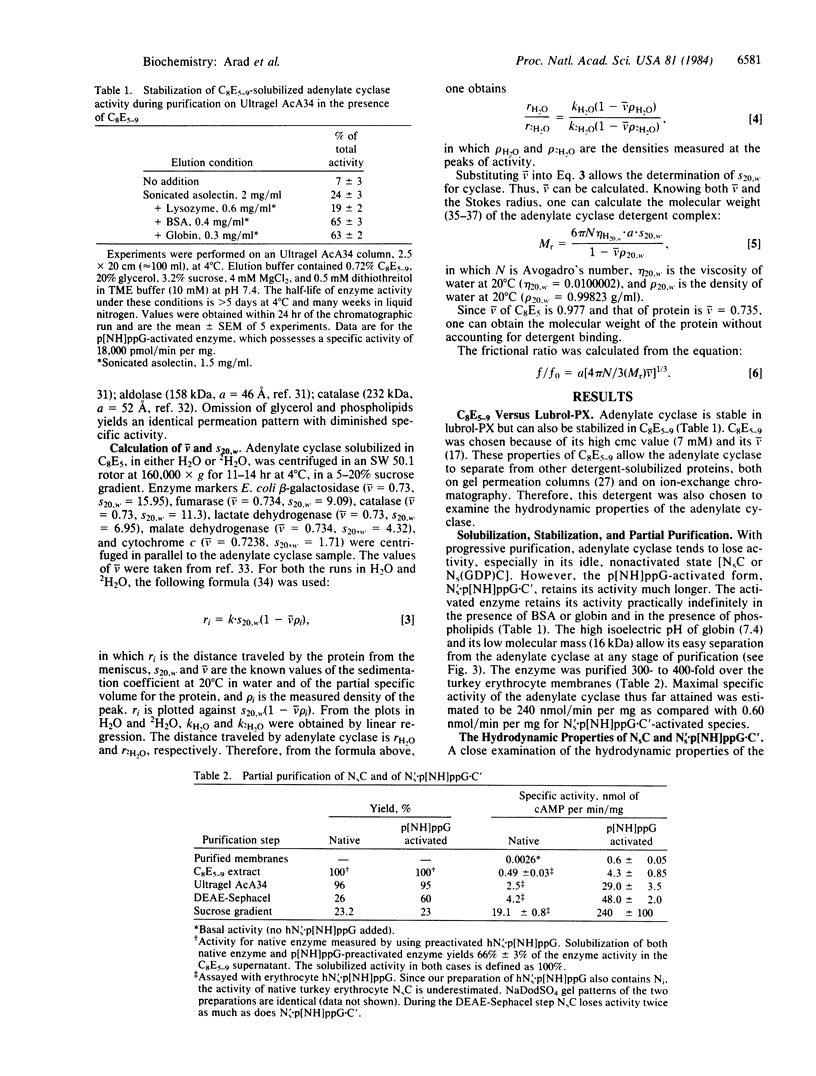
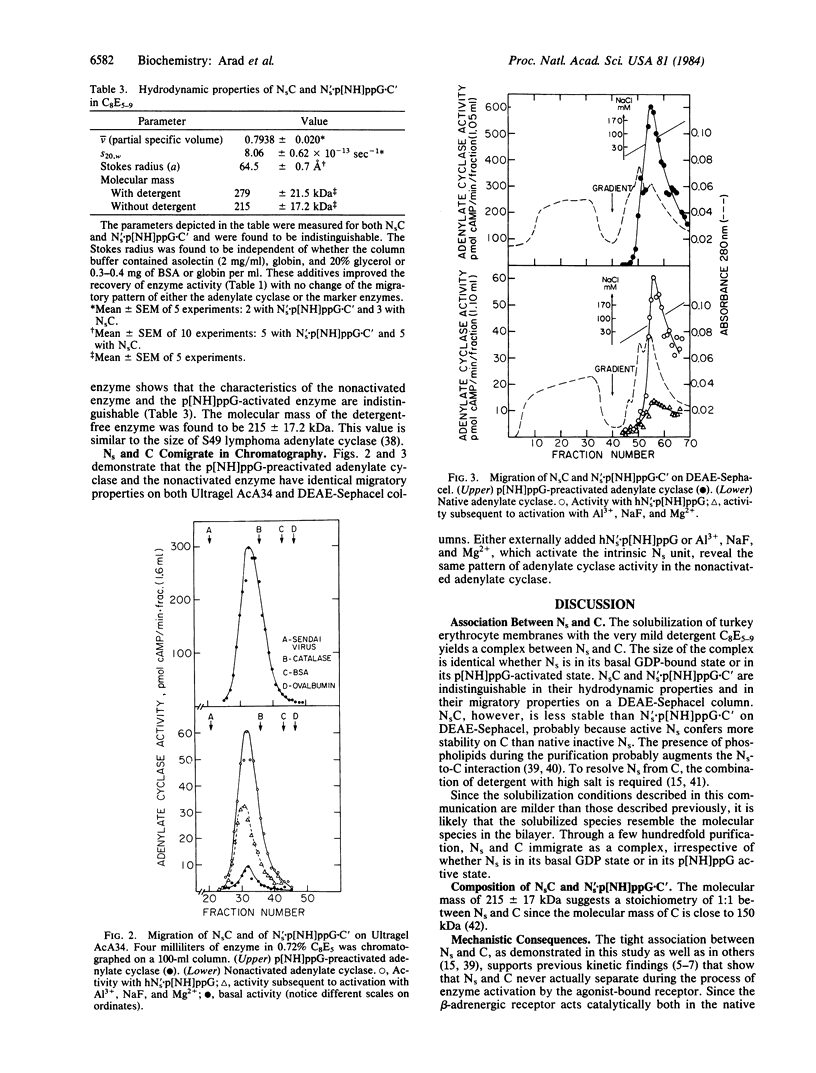
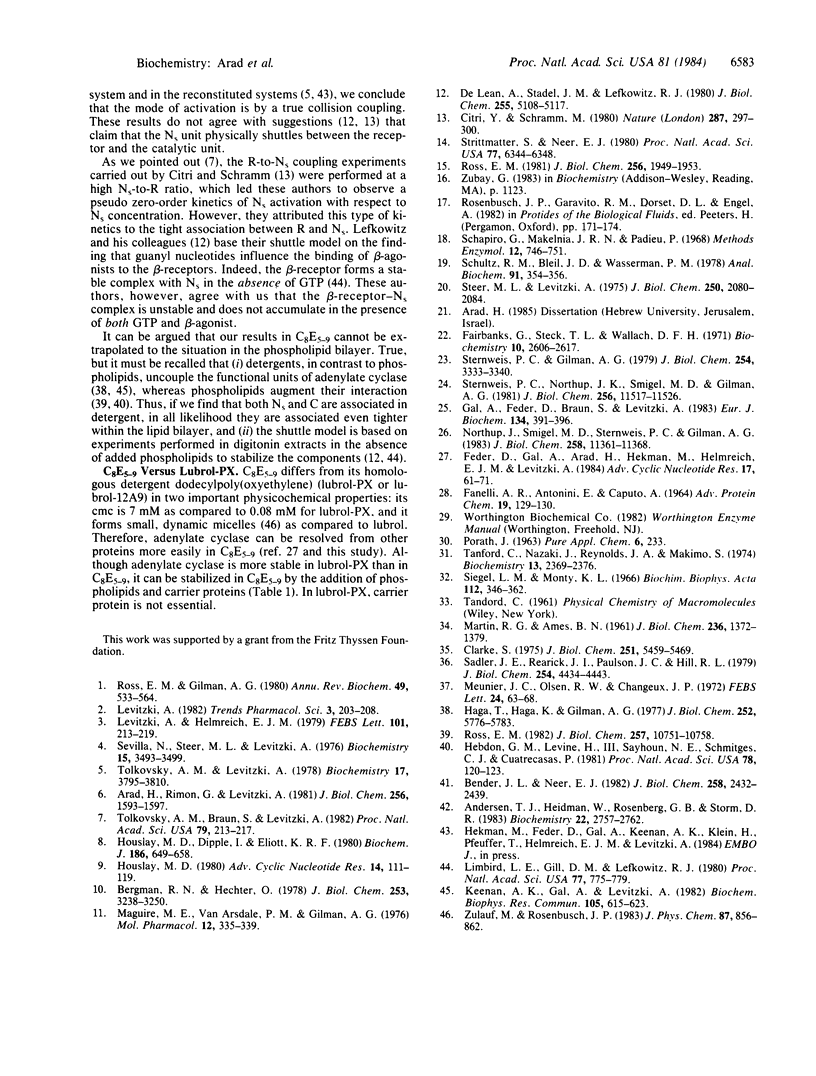
Selected References
These references are in PubMed. This may not be the complete list of references from this article.
- Andreasen T. J., Heideman W., Rosenberg G. B., Storm D. R. Photoaffinity labeling of brain adenylate cyclase preparations with azido[125 I]iodocalmodulin. Biochemistry. 1983 May 24;22(11):2757–2762. doi: 10.1021/bi00280a025. [DOI] [PubMed] [Google Scholar]
- Arad H., Rimon G., Levitzki A. The reversal of the Gpp(NH)p-activated state of adenylate cyclase by GTP and hormone is by the "collision coupling" mechanism. J Biol Chem. 1981 Feb 25;256(4):1593–1597. [PubMed] [Google Scholar]
- Bender J. L., Neer E. J. Properties of the adenylate cyclase catalytic unit from caudate nucleus. J Biol Chem. 1983 Feb 25;258(4):2432–2439. [PubMed] [Google Scholar]
- Bergman R. N., Hechter O. Neurohypophyseal hormone-responsive renal adenylate cyclase. IV. A random-hit matrix model for coupline in a hormone-sensitive adenylate cyclase system. J Biol Chem. 1978 May 10;253(9):3238–3250. [PubMed] [Google Scholar]
- Citri Y., Schramm M. Resolution, reconstitution and kinetics of the primary action of a hormone receptor. Nature. 1980 Sep 25;287(5780):297–300. doi: 10.1038/287297a0. [DOI] [PubMed] [Google Scholar]
- Clarke S. The size and detergent binding of membrane proteins. J Biol Chem. 1975 Jul 25;250(14):5459–5469. [PubMed] [Google Scholar]
- Fairbanks G., Steck T. L., Wallach D. F. Electrophoretic analysis of the major polypeptides of the human erythrocyte membrane. Biochemistry. 1971 Jun 22;10(13):2606–2617. doi: 10.1021/bi00789a030. [DOI] [PubMed] [Google Scholar]
- Feder D., Arad H., Gal A., Hekman M., Helmreich E. J., Levitzki A. Resolution, reconstitution, and mode of action of the beta-adrenergic receptor-dependent adenylate cyclase. Adv Cyclic Nucleotide Protein Phosphorylation Res. 1984;17:61–71. [PubMed] [Google Scholar]
- Gal A., Braun S., Feder D., Levitzki A. Reconstitution of a functional beta-adrenergic receptor using cholate and a novel method for its functional assay. Eur J Biochem. 1983 Aug 1;134(2):391–396. doi: 10.1111/j.1432-1033.1983.tb07580.x. [DOI] [PubMed] [Google Scholar]
- Haga T., Haga K., Gilman A. G. Hydrodynamic properties of the beta-adrenergic receptor and adenylate cyclase from wild type and varient S49 lymphoma cells. J Biol Chem. 1977 Aug 25;252(16):5776–5782. [PubMed] [Google Scholar]
- Hebdon G. M., LeVine H., 3rd, Sahyoun N. E., Schmitges C. J., Cuatrecasas P. Specific phospholipids are required to reconstitute adenylate cyclase solubilized from rat brain. Proc Natl Acad Sci U S A. 1981 Jan;78(1):120–123. doi: 10.1073/pnas.78.1.120. [DOI] [PMC free article] [PubMed] [Google Scholar]
- Houslay M. D., Dipple I., Elliott K. R. Guanosine 5'-triphosphate and guanosine 5'-[beta gamma-imido]triphosphate effect a collision coupling mechanism between the glucagon receptor and catalytic unit of adenylate cyclase. Biochem J. 1980 Mar 15;186(3):649–658. doi: 10.1042/bj1860649. [DOI] [PMC free article] [PubMed] [Google Scholar]
- Houslay M. D. Mobile receptor and collision coupling mechanisms for the activation of adenylate cyclase by glucagon. Adv Cyclic Nucleotide Res. 1981;14:111–119. [PubMed] [Google Scholar]
- Keenan A. K., Gal A., Levitzki A. Reconstitution of the turkey erythrocyte adenylate cyclase sensitivity to 1-epinephrine upon re-insertion of the Lubrol solubilized components into phospholipid vesicles. Biochem Biophys Res Commun. 1982 Mar 30;105(2):615–623. doi: 10.1016/0006-291x(82)91479-6. [DOI] [PubMed] [Google Scholar]
- Levitzki A., Helmreich E. J. Hormone-receptor--adenylate cyclase interactions. FEBS Lett. 1979 May 15;101(2):213–219. doi: 10.1016/0014-5793(79)81011-x. [DOI] [PubMed] [Google Scholar]
- Limbird L. E., Gill D. M., Lefkowitz R. J. Agonist-promoted coupling of the beta-adrenergic receptor with the guanine nucleotide regulatory protein of the adenylate cyclase system. Proc Natl Acad Sci U S A. 1980 Feb;77(2):775–779. doi: 10.1073/pnas.77.2.775. [DOI] [PMC free article] [PubMed] [Google Scholar]
- MARTIN R. G., AMES B. N. A method for determining the sedimentation behavior of enzymes: application to protein mixtures. J Biol Chem. 1961 May;236:1372–1379. [PubMed] [Google Scholar]
- Maguire M. E., Van Arsdale P. M., Gilman A. G. An agonist-specific effect of guanine nucleotides on binding to the beta adrenergic receptor. Mol Pharmacol. 1976 Mar;12(2):335–339. [PubMed] [Google Scholar]
- Meunier J. C., Olsen R. W., Changeux J. P. Studies on the cholinergic receptor protein from Electrophorus electricus. Effect of detergents on some hydrodynamic properties of the receptor protein in solution. FEBS Lett. 1972 Jul 15;24(1):63–68. doi: 10.1016/0014-5793(72)80827-5. [DOI] [PubMed] [Google Scholar]
- Northup J. K., Sternweis P. C., Gilman A. G. The subunits of the stimulatory regulatory component of adenylate cyclase. Resolution, activity, and properties of the 35,000-dalton (beta) subunit. J Biol Chem. 1983 Sep 25;258(18):11361–11368. [PubMed] [Google Scholar]
- Ross E. M., Gilman A. G. Biochemical properties of hormone-sensitive adenylate cyclase. Annu Rev Biochem. 1980;49:533–564. doi: 10.1146/annurev.bi.49.070180.002533. [DOI] [PubMed] [Google Scholar]
- Ross E. M. Phosphatidylcholine-promoted interaction of the catalytic and regulatory proteins of adenylate cyclase. J Biol Chem. 1982 Sep 25;257(18):10751–10758. [PubMed] [Google Scholar]
- Ross E. M. Physical separation of the catalytic and regulatory proteins of hepatic adenylate cyclase. J Biol Chem. 1981 Feb 25;256(4):1949–1953. [PubMed] [Google Scholar]
- Sadler J. E., Rearick J. I., Paulson J. C., Hill R. L. Purification to homogeneity of a beta-galactoside alpha2 leads to 3 sialyltransferase and partial purification of an alpha-N-acetylgalactosaminide alpha2 leads to 6 sialyltransferase from porcine submaxillary glands. J Biol Chem. 1979 Jun 10;254(11):4434–4442. [PubMed] [Google Scholar]
- Schröder H. C., Dose K., Zahn R. K., Müller W. E. Isolation and characterization of the novel polyadenylate- and polyuridylate-degrading acid endoribonuclease V from calf thymus. J Biol Chem. 1980 Jun 10;255(11):5108–5112. [PubMed] [Google Scholar]
- Schultz R. M., Bleil J. D., Wassarman P. M. Quantitation of nanogram amounts of protein using [3H]dinitrofluorobenzene. Anal Biochem. 1978 Nov;91(1):354–356. doi: 10.1016/0003-2697(78)90850-3. [DOI] [PubMed] [Google Scholar]
- Sevilla N., Steer M. L., Levitzki A. Synergistic activation of adenylate cyclase by guanylyl imidophosphate and epinephrine. Biochemistry. 1976 Aug 10;15(16):3493–3499. doi: 10.1021/bi00661a015. [DOI] [PubMed] [Google Scholar]
- Siegel L. M., Monty K. J. Determination of molecular weights and frictional ratios of proteins in impure systems by use of gel filtration and density gradient centrifugation. Application to crude preparations of sulfite and hydroxylamine reductases. Biochim Biophys Acta. 1966 Feb 7;112(2):346–362. doi: 10.1016/0926-6585(66)90333-5. [DOI] [PubMed] [Google Scholar]
- Steer M. L., Levitzki A. The control of adenylate cyclase by calcium in turkey erythrocyte ghosts. J Biol Chem. 1975 Mar 25;250(6):2080–2084. [PubMed] [Google Scholar]
- Sternweis P. C., Gilman A. G. Reconstitution of catecholamine-sensitive adenylate cyclase. Reconstitution of the uncoupled variant of the S40 lymphoma cell. J Biol Chem. 1979 May 10;254(9):3333–3340. [PubMed] [Google Scholar]
- Sternweis P. C., Northup J. K., Smigel M. D., Gilman A. G. The regulatory component of adenylate cyclase. Purification and properties. J Biol Chem. 1981 Nov 25;256(22):11517–11526. [PubMed] [Google Scholar]
- Strittmatter S., Neer E. J. Properties of the separated catalytic and regulatory units of brain adenylate cyclase. Proc Natl Acad Sci U S A. 1980 Nov;77(11):6344–6348. doi: 10.1073/pnas.77.11.6344. [DOI] [PMC free article] [PubMed] [Google Scholar]
- Tanford C., Nozaki Y., Reynolds J. A., Makino S. Molecular characterization of proteins in detergent solutions. Biochemistry. 1974 May 21;13(11):2369–2376. doi: 10.1021/bi00708a021. [DOI] [PubMed] [Google Scholar]
- Tolkovsky A. M., Braun S., Levitzki A. Kinetics of interaction between beta-receptors, GTP protein, and the catalytic unit of turkey erythrocyte adenylate cyclase. Proc Natl Acad Sci U S A. 1982 Jan;79(2):213–217. doi: 10.1073/pnas.79.2.213. [DOI] [PMC free article] [PubMed] [Google Scholar]
- Tolkovsky A. M., Levitzki A. Mode of coupling between the beta-adrenergic receptor and adenylate cyclase in turkey erythrocytes. Biochemistry. 1978 Sep 5;17(18):3795–3795. doi: 10.1021/bi00611a020. [DOI] [PubMed] [Google Scholar]


